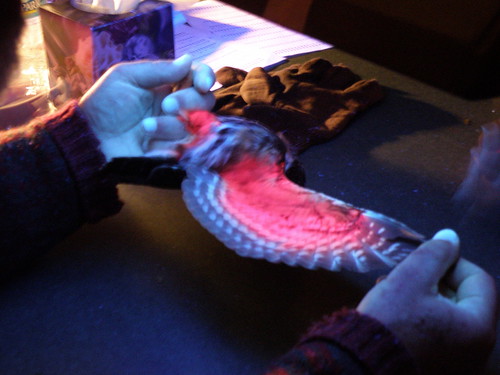Good afternoon! I'm so excited to be writing on a blog instead of Twitter! I have so much to say, and for once I'm not limited by 140 characters! Such latitude...wow! Okay, I should hold back on the exclamation points, otherwise the Great Horned Owl will come through and edit them all out. She can be so stodgy sometimes!
Okay, so, American Kestrels! I'm going tell you about why I (ahem...why we) are so awesome! But there's so much to talk about, I don't even know where to start. How about we start with the basics?
American Kestrels are falcons, just like the Peregrine Falcons that everyone seems to know about and love, except we're much smaller. For instance, I weigh 117 grams at the moment, about the same as a quarter-pound burger.
We are the smallest North American falcon, and also the most common (but that doesn't make us any less special!)

American Kestrels are actually one of the only North American raptors with a color "sexual dimorphism". That's a fancy Human word that means "males look different than females". The ladies are a russet brown color all over, while the males (like me) have bluish-grey coloring on their wings and heads. In the picture to the left, the male is on the right/bottom, and the female (yowza!) is on the left/top. You can also see there that the male and female have very different tail patterns and streaking patterns.
Just so you know, the other North American raptors with overt sexual dimorphisms like that are the Merlin (another falcon) and the Northern Harrier. I'm sure the Owl will write more about them later.
Also, like most falcons, we have that stylish "chinstrap" mark below our eyes. It's there to help us see better in the sun, just like how football players and baseball players smudge black paint below their eyes to get rid of glare.
 |
| See the resemblance?? |
 |
| The green spot circled in red is how I see vole pee. Are you jealous yet? |
Seeing in the UV spectrum makes a lot of things more noticeable and interesting, like the feathers of other birds, and otherwise-unseen patterns on flowers:
 |
| Saw-Whet Owl feathers in the UV spectrum |
 |
| I don't really care about flowers, but it's still a cool picture |
 |
| thebirdersreport.com |
As for how we actually catch voles, it's really interesting, too! Our wingtips are specially designed to allow us to hover. Now, I'm not talking the same caliber of hovering that hummingbirds pull off, but we do hang out in the air without really going places, so yeah, it's hovering. It requires the right kind of breeze, then we flap the wing tips just enough to stay airborne while looking down at the ground (at those vole trails!) waiting for lunch to come scurrying along. Then we swoop down, and, like all raptors, catch the little snack with our feet.
 |
| seagullsteve.blogspot.com |
The other [far easier but slightly less fun] way to hunt is to hang out on a branch tip or a powerline and wait for something to walk by. If you keep your eyes peeled while driving along a highway, I guarantee you'll see loads of Kestrels either hovering or perching on powerlines.
Other than mice and voles, Kestrels are big on hunting bugs. Oh yeah, bugs. So tasty and full of protein! We're really big fans of grasshoppers in particular, just like the Swainson's Hawks are.
Um, wow, am I running out of things to talk about? That can't be possible. Kestrels are renowned for having lots to say all the time. In fact, I often see the Humans covering their ears so they can block out the piercing "klee klee klee!" sound we make! We're also very critical and can't help but comment on everything going on around us.
Huh. Well, I guess I am out of things to say. But don't worry, I'm sure I did a stellar job writing this, and I bet the Great Horned Owl will let me write about the other falcons, too! And if I did forget to mention something here, I'll just post it on my Twitter account (@RaptorProgram). Catch ya later!!
 |
| This is me editing my Physical Form after the Humans are done writing it. |
Um, wow, am I running out of things to talk about? That can't be possible. Kestrels are renowned for having lots to say all the time. In fact, I often see the Humans covering their ears so they can block out the piercing "klee klee klee!" sound we make! We're also very critical and can't help but comment on everything going on around us.
Huh. Well, I guess I am out of things to say. But don't worry, I'm sure I did a stellar job writing this, and I bet the Great Horned Owl will let me write about the other falcons, too! And if I did forget to mention something here, I'll just post it on my Twitter account (@RaptorProgram). Catch ya later!!


No comments:
Post a Comment